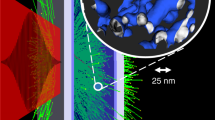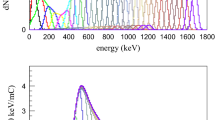Abstract
We discuss the preliminary estimates to create Neutron Star atmospheric conditions in the laboratory and the possibility of generating photon bubbles. The minimal requirements for photon-bubble instability could potentially be met with a properly configured 10 ps petawatt laser experiment. The high energy (multi-MeV) electrons generated by an ultra-intense laser interacting with a foil are coupled to the electrons in the solid to heat the entire solid generating high thermal temperatures. Small amounts of matter could potentially be heated to ~1 keV temperatures with large radiation temperature. Additionally, 2-D PIC simulations show large B-fields on both the front and back of these targets with B fields consistent with experiments using the petawatt at Rutherford Appleton Laboratory (Tatarakis, M. et al.: 2002c, Nature 415, 280).
Similar content being viewed by others
References
Arons, J.: 1992, ApJ 388, 561.
Blaes, O. and Socrates, A.: 2003, ApJ 596, 509.
Hsu, J.J.L., Arons, J. and Klein, R.I.: 1997, ApJ 478, 663.
Jernigan, J.G., Klein, R.I. and Arons, J.: 2000, ApJ 530, 875.
Klein, R.I. et al.: 1996a, ApJ 469, L119.
Klein, R.I., Arons, J., Jernigan, G. and Hsu, J.J.L.: 1996b, ApJ 457, L85.
Klein, R.I. and Arons, J.: 1989, in N.E. White and T.D. Guyenne, Proceedings of 23rd ESLAB Symposium on Two Topics in X-ray Astronomy, ESA SP-296, ESA, Paris.
Klein, R.I. and Arons, J.: 1991, in Stellar Atmospheres: Beyond Classical Models, L. Crivillari (ed.), Kluwer, Boston, p. 205.
Klein, R.I., Budil, K.S., Perry, T.S. and Bach, D.R.: 2003, ApJ 583, 245.
Remington, B.A., Arnett, D., Drake, R.P. and Takabe, H.: 1999, Science 284(5419), 1488.
Remington, B.A. et al.: 2000, Phys. Plasmas 7(5), 1641.
Robey, H.F. et al.: 2002, Phys. Rev. Lett. 8908(8), 5001.
Ryutov, D.D. and Remington, B.A.: 2002, Plasma Phys. Control. Fussion 44(12B), B407.
Tatarakis, M. et al.: 2002a, Phys. Plasmas 9(8), 3642.
Tatarakis, M. et al.: 2002b, Phys. Plasmas 9(5), 2244.
Tatarakis, M. et al.: 2002c, Nature 415, 280.
Wilks, S.C. and Kruer, W.L.: 1997, IEEE J. Quantum Elect. 33(11), 1954.
Author information
Authors and Affiliations
Corresponding author
Rights and permissions
About this article
Cite this article
Moon, S.J., Wilks, S.C., Klein, R.I. et al. A Neutron Star Atmosphere in the Laboratory With Petawatt Lasers. Astrophys Space Sci 298, 293–298 (2005). https://doi.org/10.1007/s10509-005-3949-6
Received:
Accepted:
Issue Date:
DOI: https://doi.org/10.1007/s10509-005-3949-6




